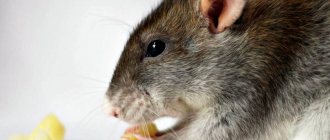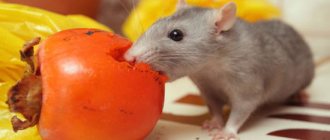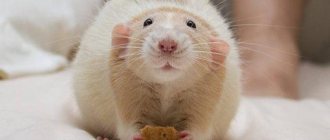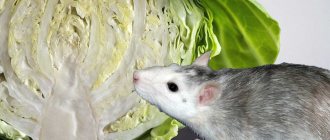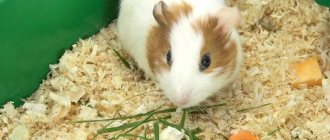Bananas and pet rats don't seem to mix. But the fact is that rats love to pop bananas or banana chips into their mouths if they find them nearby. What to do if your pet starts eating banana? Is it worth taking the fruit away from a rodent? Is this fruit safe for rats or can feeding bananas lead to dangerous consequences?
Bananas are a very common delicacy among people. This fruit is considered healthy due to its high percentage of vitamins and minerals. But not all human food is suitable for feeding rats. Let's find out whether this healthy fruit can be given to rats.
Is it possible to give banana to rats?
For good growth and development of the body of rodents, they should be given a variety of fruits and vegetables, which contain many useful vitamins.
Bananas are allowed for decorative rats!
The main thing is to follow the dose and not over-feed the animal, as the fruit causes obesity in rats, which can ultimately shorten life expectancy.
Bananas should be given to your pet ripe or dried.
In what quantities?
To avoid mistakes in feeding bananas to domestic rats, you should know that the weekly consumption rate is 15 g.
Therefore, no more than 2.5 g of fruit should be consumed per day. But you should not abuse this product. It is better to use it occasionally, as a treat. Decorative rats are very trainable, so for a well-done trick, you can treat it with a piece of banana.
What can you feed decorative rats?
- Buckwheat. This low-calorie product is suitable even for decorative rats suffering from diabetes.
- Millet (millet) is an excellent component of feeding decorative rats.
- Barley (pearl barley).
- Rye.
- Rice.
- Basil.
- Zucchini (in any form).
- Cilantro.
- Carrots (in any form). However, keep in mind that in large quantities this product can cause digestive upset in a decorative rat.
- Cucumbers.
- Parsley leaves.
- Salad: field lettuce (corn), iceberg, arugula, Chinese cabbage, lettuce, spinach.
- Celery is also beneficial for pet rats.
- Pumpkin (any form).
- Dill is another product that can be fed to your kitten rat.
- Zucchini (any form).
- Watermelon (however, keep in mind that early watermelon may contain nitrates). You can also feed your kitty rat seeds.
- Avocado.
- Apricots.
- A pineapple.
- Hawthorn (but it reduces blood pressure).
- Cherry.
- Grape.
- Melons (however, early melons can be “rich” in nitrates).
- Strawberry wild-strawberry.
- Cranberry.
- Mango.
- Raspberries.
- Peaches.
- Rowan (red).
- Currant.
- Persimmon (but only sweet and ripe).
- Blueberry.
- Rosehip (dried).
- Apples (including seeds).
- Varenets.
- Yogurt (preferably natural, without dyes, sugar and other additives).
- Kefir.
- Ryazhenka.
- Cottage cheese.
- Gamarus.
- Zofobas.
- Bones (boiled).
- Seafood (boiled).
- Meat, including poultry (boiled). You cannot feed a decorative rat pork!
- Meat by-products (boiled).
- Fish (boiled).
- Dry food, dog and cat (but only very good quality!)
- Eggs (quail or chicken, boiled). The yolk is soaked, otherwise the rat may choke.
Tomatoes
Can rats eat tomatoes? The answer to this question is also positive. But these vegetables should only be given when ripe and in small quantities, since they contain acids. Unripe fruits contain solanine, just like leaves and tops, so they should not be fed. Pickled and canned tomatoes are also contraindicated for pets. If you do not grow your own vegetables, then tomatoes can only be given to rats during the season.
Pepper
Bell pepper contains many vitamins. Therefore, rats can have pepper, but only once a day, if your pet is not prone to increased gas production.
Eggplant
Inexperienced breeders are often interested in whether rats can eat eggplants. Before feeding this vegetable to your pet, it is necessary to wash it well, peel it and heat it. Leaves and tops should not be fed to a rodent because of the solanine they contain.
Cabbage
But can rats eat cabbage? Red, white, and Brussels sprouts should not be given to pets, since this vegetable increases gas formation in rats. Broccoli and cauliflower can be eaten in small quantities and only for individuals who are not prone to increased gas formation.
Carrot
Rats can eat carrots raw. Just do not overfeed your pet with this vegetable to prevent intestinal upset. Also, overeating carrots can cause allergies and hypervitaminosis, which in turn leads to eye problems.
Zucchini
Can rats eat zucchini? Zucchini and zucchini can be given raw, boiled or steamed.
Potato
Can rats have potatoes and in what form can they be given to them? Raw potatoes should not be fed to your pet due to their high starch content. Offer your rodent a small piece of boiled potato, but no more than a couple of times a week. It is also prohibited to feed potato tops, sprouts and green tubers to rats, as they contain poisonous solanine. Do not give your pet chips, even as a treat.
Corn
Corn can be offered to rats raw or cooked, only in small quantities as a treat. Canned corn should not be fed to pets. You can also offer your pet popcorn as a treat, only if you made it yourself, without salt, sugar or spices.
Beet
Can a rat eat beets? It is possible, but not often and in small quantities, since this vegetable has a laxative effect. You can give beets raw or boiled.
Radish
Can rats have radishes? Radishes and turnips increase gas production, so they should not be fed to rats. Although there are messages on forums about feeding pets with these products. But we do not recommend doing this. Do not give your pet foods that may cause him discomfort.
Pumpkin
Pumpkin is a very healthy vegetable because it contains fiber, proteins, vitamins and other beneficial substances. Therefore, to the question: can rats eat pumpkin, there is one answer - yes, they can. Pumpkin is fed to rodents raw and boiled. You can also offer your pet pumpkin seeds, they are healthier than sunflower seeds. In addition, they are an excellent prophylaxis against helminths. But you also shouldn’t overdo it with them, since they are fatty. A rat can be given no more than 10 pieces. in Week.
Onion and garlic
Onions and garlic are very spicy for rats and your pet may refuse to eat them, but a rodent may like young green onions. Onions and garlic are most often offered as an antibiotic and antiviral agent for diseases, only in small quantities.
Peas
Peas increase gas formation, so it is not advisable to feed them to rats. You should also not feed your pets canned green peas. But you can occasionally offer your pet some fresh green peas, either from the pod or boiled.
Beans
Rats should not eat raw beans and other legumes, as they increase gas formation. But there is an opinion that sometimes legumes can be offered to rodents only after heat treatment.
Rats can diversify their diet with various vegetables, both raw, boiled and steamed. Boiled ones, in turn, can be offered to your pet in the form of small pieces or puree. But most importantly, try not to give vegetables that could harm your pet or cause discomfort. These vegetables can be very healthy with a huge amount of vitamins. But if they can make a rat feel bad, then why experiment on the animal and try to feed it with foods that are not recommended to be fed to these rodents.
Love your pets, follow the rules of care and feed them correctly. Now you know what vegetables a rat can eat, and which ones your pet should refrain from eating.
Did you like the article? Share with friends: [supsystic-social-sharing id=”1"]
- Related Posts
- Rat breeding
- How rats laugh and why they do it
- Pregnancy in rats
« Previous entry
Vegetables and greens
Among vegetables, foods that cause fermentation are prohibited: white and red cabbage, Savoy and Brussels sprouts, as well as cauliflower. Rats can eat broccoli in small quantities. Strong gas formation is caused by radishes, turnips and radishes, as well as all types of legumes: beans, peas, beans and lentils. You should be careful when giving sweet peppers; some animals have the same reaction to it. You can sometimes offer boiled green beans if they do not cause gas in your pet. Carrots, zucchini, zucchini and pumpkin are delicious and healthy foods. Cucumbers in excess will cause diarrhea. Eggplants are only good when cooked; solanine in raw vegetables can cause poisoning. Artichokes can also only be given cooked. Potatoes will not bring any benefit to the animal. In its raw form it is contraindicated for animals, but when cooked it acts as ballast. However, some rodents enjoy eating potatoes.
Vegetables, fruits and herbs should be given daily in small quantities - 10-12 g.
Dill, cilantro, parsley, basil and celery are healthy foods for animals and can be given every day. They are not only safe, but also help digest protein foods. Onions, garlic and wild garlic are not suitable due to phytoncides that irritate the gastrointestinal mucosa. They should be given occasionally and in limited quantities. Acidic vegetables such as tomatoes, rhubarb and sorrel can also eat away at the delicate walls of a rodent's stomach. You should not give animals spinach either. Beets carry another danger - a laxative effect, they should be given carefully. Leaf lettuces that do not have a specific bitterness are generally suitable for animals.
Grain and cereals
Grains are the main product in the diet of rats, but they are not equally important. Wheat is a rich, high-calorie product; it can be given to rats, but it must be taken into account that it must be supplemented with other components. The mixture may include oats, buckwheat, corn, rye, barley or pearl barley, rice, millet or millet. These grains are not equal. Buckwheat is a dietary low-calorie product, and corn, on the contrary. Oats should be added in small quantities; excess may cause fermentation. Refined rice is low in nutrition, so it's worth finding a wild rice blend or an unrefined version of the grain.
Semolina does not contain anything useful, so this product should be excluded from the diet. Barley or wheat cereals are suitable for porridges. Porridge is useful only for weakened, emaciated animals or young animals. Adult rats should only give them as a treat.
Criterias of choice
If you still want to treat your little rodent with a treat, you need to understand the right choice of fruit.
The banana should not contain any green coloring, otherwise you will feed your pet solid starch. There should be small black spots on it, which means the fruit is ripe. You can also determine ripeness by smell. A yellow banana will have no odor, but the aroma of the spotted yellowish fruit will not let you pass by.
Remember, the main diet of rats: cereals, grains, dairy products and lean meat. Banana is a fruit that provides vitamins to animals. Protein is necessary for full functioning and health. It supports immunity and develops bones and muscle tissue.
Knowing all the subtleties in choosing and consuming bananas, you can not only not harm the little rodent’s body, but also please him with a pleasant treat from which he will receive the necessary vitamins.
Great article 9
Feeding rats video
Other similar posts:
Sea kale is rich in iodine, just like human rats also need this element.
It is best to purchase dry seaweed at a pharmacy and add it to your main feed. A rodent may have problems with the thyroid gland if its diet lacks iodine. Additionally, you can use mineral stone with algae and seafood in your diet.
You can buy seaweed in the store. It is good to rinse off the brine in several waters and offer it to the animal. The rats definitely won't eat much. We remove the remains from the cage.
It is enough to give seaweed once a week. The dry one is pre-soaked in water and offered to the animal. Its taste is not the most delicious, so you can add it to cottage cheese, yogurt or baby food.
Remember, this is the same as vitamins for humans. It's not worth giving a lot. Dry seaweed is taken on the tip of a knife (1/6 tsp) and diluted in 1-2 drops of water.
If the animal does not want to eat, do not force it. Suggest at another time. Can be stored in the refrigerator.
Great article 4
Some general details about feeding a decorative rodent
Eating is a favorite pastime of rats, but they can get carried away or, in general, eat what they shouldn’t, so the pet owner must pay great attention to the selection and preparation of the correct diet for the animal. In order for the nutrition to be as balanced as possible, it is best to create a diet according to a special scheme, which implies that the following products will be given to the animal regularly:
In order for the nutrition to be as balanced as possible, it is best to create a diet according to a special scheme, which implies that the following products will be given to the animal regularly:
- Cereals. Grains should form the basis of the diet you plan to feed your pet rat. You can buy special sets of cereals in pet stores, cook porridge from cereals (without adding oil to them), give boiled pasta, bread, boiled corn;
- Vegetables, herbs and fruits are what you can “treat” and feed your rat deliciously every day. Moreover, a “green” diet is necessary for the animal’s full functioning and for its health. Don't feed your rat exclusively carrots and cabbage - these pets love variety and need a wide variety of vitamins;
- You can provide your animal with additional vitamin supplementation by buying him special treats enriched with microelements and other useful substances. For rats, pet stores sell vitamin lozenges, sticks, and candies;
- Protein-rich foods are also necessary for the rat, but they should be given much less frequently than vegetables and grains - it is enough to offer protein to the rodent once every two days. Meat, seafood, cottage cheese, cheese, and yogurt can be used as protein foods. Do not give your rat protein in large quantities - an excess of this substance is harmful to the animal’s body; rodents with an abundance of protein in the blood age faster.
The animal must feed regularly - a rat can live for a maximum of two days without food. But it’s also not worth it to be overzealous and stuff the animal with food all the time - rats can gain excess body weight, and they will develop obesity.
Quality grapes - what are they?
Many owners are very mistaken in believing that a decorative rat should and can eat absolutely everything. Including products that are far from fresh. When choosing grapes, you need to focus on fresh bunches. Rotten berries will bring neither benefit nor pleasure to a rodent. When choosing grapes, pay attention to their appearance.
The best solution is to provide grapes grown in environmentally friendly conditions and without chemical treatment. Such berries can be collected at your summer cottage or bought from a small farmer at the market.
If wasps are constantly flying around a stand with grapes, this is an indication that it has not been treated with harmful chemicals. You can safely buy such berries. If you purchased them in a store, then before giving them to your pet, pour boiling water over them several times.
Fruits
All citrus fruits should be immediately excluded from the rats' diet due to the acidity. Occasionally you can give a piece of sweet tangerine. Forest and garden berries must be sorted according to their acid level. Thus, cranberries, which are useful in many respects, should be given with caution because of their taste.
Sweet cherries are more suitable than sour cherries. Never give animals seeds from fruit trees or citrus fruits. They can be poisonous to rodents. You should pay attention to the special properties of fruits. Chokeberry and bird cherry strengthen, and plum weakens. This must be taken into account when choosing food. Pear can cause fermentation in some individuals. Watermelons and melons can be given in small quantities and only in season, as they accumulate nitrates.
Dried fruits are too sweet and may cause fermentation. They should be given carefully, as a treat.
What should pet rats not eat?
When feeding rodents at home, it is very important to know and select healthy foods.
Domestic rodents living in a cage are strictly prohibited from giving fried, baked, pickled, spicy, sweet and salty foods. You should not give hard and moldy cheeses, sausages of all types, homemade lard, raw beans, white cabbage and potatoes. Some pets also like to eat plants. Many housewives in their apartments have plants such as begonia, kalanchoe, geranium, cyclamen; they are poisonous and can cause irreparable harm to the body, so it is better to get rid of these species or move them to a secluded place.
What kind of insulation do rats and mice not eat?
The necessary material in a private home is insulation. Modern materials that retain thermal conductivity and reduce energy consumption become objects of eating by rodents. Let's look at examples of insulation materials that are not “appetizing” for these rodents.
Usually they choose foam plastic or mineral wool to furnish their warm nests. Other insulation materials, such as foam glass, expanded clay and liquid wall insulation, do not at all attract them as a culinary value. Foam glass consists of a dense structure made by foaming glass raw materials with a carbon mixture, resulting in the formation of glass cells. Expanded clay has a similar structure, this is enough to prevent rats and mice from getting interested in the delicacy of the insulation.
Source
How to choose the right treat for your rat
What should an ideal banana be like, or something close to it, that will not harm the animal’s body, but, on the contrary, will strengthen and be beneficial?
Veterinarians recommend paying attention to the following points when choosing treats for your pet:
- Product color. A quality banana should be yellow, not green.
- The presence of small black spots on the fruit. The appearance of such marks is a sign of product maturity.
- Smell. The pure yellowish fruit has no odor, while the rich yellow fruit with black spots has a different aroma from the others.
Veterinarians do not prohibit treating rats with bananas and even advise doing so. To ensure that the introduction of a new product to an animal’s menu is painless and does not bring sad and irreparable consequences, breeders should study the basic information, namely, find out when and in what doses this fruit can be given, and when it is better for the body and preserving the life of the animal to abandon this idea and think about treating him to another treat.
What do rodents like?
Biologists and professional deratizers (pest extermination specialists) agree that mice are more often “led” to delicacies of plant origin, while rats love animal products. But when a rodent has been hungry for a long time, it will eat whatever it finds. That is why at first it is difficult to determine who is in the house. In view of what has been described, employees of non-food industry enterprises resort to a trick - they use poisoned grain to destroy parasites. It’s cheap and works 100%, because pests have no other food.
Mice
Based on the above, the best mouse baits are:
- fresh baked goods - a fragrant wheat bun, muffin, gingerbread or a piece of soft white bread will attract the pest almost instantly;
- seeds - in the wild, mice eat grains and willingly feast on them in our homes;
- nut – as appetizing as grains;
- a slice of apple, pear, plum or peach - familiar fruits with a bright smell often become food for mice in the wild;
- peanut butter - nut paste has a pronounced aroma and smells fragrant for many meters.
Rats
Rats are practically omnivorous. They can be caught using any delicacy, but we recommend:
- lard is a product with a bright, spicy aroma that attracts rodents like a magnet;
- sausage - only high-quality sausage products will do; rats often refuse cheap ones, stuffed with chemicals;
- fresh meat - the specific smell that various parts of a chicken or pig carcass emit attracts pests;
- minced meat is an almost ideal bait for rats, better with the addition of onions;
- smoked fish is a very flavorful option that can catch the maximum number of rodents;
- vegetable oil – “fragrant” unrefined sunflower oil can be used in combination with a piece of bread.
Is Ulan-Ude in danger of a rat invasion?
After a series of attacks by stray dogs on people in the capital of Buryatia, their number has decreased significantly. However, according to city residents, the fight against stray dogs gives rise to another problem - an increase in the rat population. Is this true or not? We turned our question to specialists from the Republican Center for Hygiene and Epidemiology.
Dangerous neighbors
Currently, at least 64 species of these animals are found in the world. Rats eat almost any food. In search of food and new nesting sites, they can travel up to 20 kilometers, and swim all 30 kilometers. Due to the anatomical feature, rodents easily penetrate through cracks and holes four times smaller than their own body size. Possessing constantly growing and strong teeth, rats are able to gnaw holes and passages even in brick and concrete monolithic walls.
Wrong mixtures
Some people give their rats hamster food, but this is not the best option. The fact is that it contains too many sunflower seeds and peanuts, which cause health problems.
There are many alternative foods, particularly hazelnuts. This is a good source of protein and a great way for your rat to exercise his jaws.
The rat is entirely dependent on you for food. By providing her with proper nutrition, you will get a healthy pet.
Special food for rats will give your pet all the substances it needs.
However, he won’t refuse a small treat either.
The most effective traps
Several of the most effective methods are used to control pests. These are poisonous baits, ultrasonic repellers, mousetraps that kill or catch animals alive, and sticky traps.
Each method has its own characteristics, advantages and disadvantages. To choose the appropriate option, you should consider them in more detail.
Poison traps
Placed in places closest to nests or movement routes of animals. Often made from seeds or grains. Rodenticides can be purchased at pharmacies.
The drugs are made on the basis of substances that block blood clotting. As a result, rodents die from internal bleeding. Such baits should not be used in areas where pets live.
Ultrasonic repellers
This method is considered the most humane and safe for both animals and humans. Such devices produce sounds at a certain frequency.
For humans they are imperceptible, but for rats they are simply unbearable . Some models, in addition to ultrasound, are capable of emitting special sound signals and scaring away beepers using light flashes.
The combination of several effects completely kills the desire of pests to be near such powerful stimuli. In the first few days of using repellers, an increase in the number of rats may be observed, but do not be alarmed, this is a normal reaction.
Ultrasound causes real panic in pasyuki, forcing them to be active during the daytime and chaotic movements around the house. In a couple of weeks the room will be completely cleared of parasites.
Another safe and humane way to control rodents is with essential oils. Animals simply cannot stand the smell of mint and try to stay away from it.
Rat traps
If there are a lot of pests, you can try to catch them with a rat trap. To do this, you need to use the best baits that were listed above.
When setting traps, it is important to ensure that there are no small children or pets nearby.
Compared to poisons, mousetraps have undeniable advantages . A poisoned rat can die anywhere in the house. The corpse under the floor will poison the air with an unpleasant odor for a long time.
Traps with bait for rats are located along the walls, in areas where rodents or traces of their presence have been noticed. Typically traps are placed perpendicular to the wall.
In addition to devices that kill animals, there are also so-called “live traps”. They confine the animal without injuring it. This allows you to release the rat into the wild, the main thing is to do it away from your home.
Sticky traps
Usually used for catching mice, since their weight is much less than that of a rat. The animal, running along its usual routes, ends up on a sticky surface from which it cannot get out.
If such a trap is glued to the body of a person or pet, it can be removed using vegetable oil.
The installed traps are checked every day. All manipulations must be carried out with rubber gloves.
What should you remember when feeding your pet rodent?
First of all, it is worth understanding the difference between a domestic rat and a street gray “beast”. Representatives of the second species are dangerous to humans. They are carriers of diseases and are omnivores. Each homeowner, independently or with the help of special services, tries to eliminate street rats. But a pet has many differences:
- a clean animal and does not spread pathogens;
- smaller in size;
- afraid of drafts and prone to colds;
- not considered omnivorous.
Decorative rats are not carriers of infections and are very clean
All these facts point to special care and ways of creating a rodent’s diet.
Feeding a pet rat
Any type of rat at home should have a balanced diet. It should include vitamins, cereals, fresh vegetables and fruits, and cereals. Don't forget about chalk and branches of fruit trees. These two products help sharpen your teeth and at the same time clean them. Rusks and cabbage rolls are an excellent way not only to refresh yourself, but also to strengthen the tooth enamel of a rodent. But you shouldn’t overfeed either.
Special feeds containing various cereal crops are sold
Let's move on to gastronomic preferences. All types of rats love cheese. But you shouldn’t give them in large quantities. The intestines can quickly become clogged and the pet will have problems with its functioning. Variety is good, but you should understand that animals are small and frequent changes in food lead to problems with digestion and liver function.
Feeding a pregnant rat
Like any pregnant woman, a decorative rat needs increased nutrition and a large amount of useful and necessary vitamins and minerals. The diet immediately includes boiled poultry and fish. Cartilage from chicken bones is suitable. Vegetables and fruits – apples. Can rats eat grapes in this position? Grapes are always useful. But in order for the female to give birth well, and the pups not to be too large, the grapes are limited to a minimum. At the same time, completely exclude the seeds from the grapes. Liver, fresh wheat grass and broccoli also fall under minimalism.
The first half of pregnancy is the most important for bearing. Therefore, experts strongly recommend not to overfeed your pet, but instead of feeding it twice a day three times a day. Tomatoes and onions become dangerous.
The second half of pregnancy provides an opportunity to increase the female’s diet. Now you can include in the menu in addition to meat and fish:
- cottage cheese and apples;
- nettle and cartilage;
- porridge.
Rats can eat apples in small quantities
The same foods and grapes fall under the taboo. All types of seeds and cucumbers. Even raisins are completely prohibited.
Feeding a newborn rat
After giving birth, females become aggressive, as they must protect their offspring. But aggression will not affect nutrition in any way. It must be complete and balanced. In fact, we continue to feed exactly as during pregnancy. But now it is necessary to provide a large amount of liquid. Be sure to add cheeses and milk to the menu. But bananas, grapes and persimmons remain taboo. But can rats have persimmons to pamper them? In no case. The fruit is poorly digested and does not allow normal excretion of feces.
Need to know! It is important for all species and ages of the rat family to have protein food daily. If there is an insufficient amount of necessary substances, namely protein, individuals begin to get sick
As for small rats, the deficiency will lead to weakened immunity, underdevelopment of bone and muscle tissue.
Feeding small rodents
Until a month of life, the mother provides nutrition and all the necessary substances for the development of the cubs. Complementary feeding or a complete transition to adult food occurs every month. From this moment on, the small animal should receive meat, fish and cottage cheese. Apples and corn (young). The list of forbidden foods included: lettuce, cucumber, tomato, mushrooms, yolk and, of course, broccoli.
The mother will provide food for the first month of life for the rat pups.
Foods that should not be given to rats
If your pet's health is important to you, do not feed it from the table. It seems that there is nothing wrong with giving a rodent a piece of apple, chicken or cracker, but this is not so. The rat may refuse its food and instead receive a high proportion of fat and carbohydrates. It will be difficult to wean an animal accustomed to a common table, which means the end of a balanced diet.
It is strictly forbidden to give your rodent alcohol, fried, smoked, salted, pickled, fatty foods, carbonated drinks and sweets.
Animal proteins
Twice, or even three times a week, animals are supposed to receive animal proteins. The following can be served at the table:
- boiled lean meat;
- hard-boiled chicken or quail eggs;
- mealworm, zoophobus (zophobas), gammarus;
- seafood;
- high quality cat or dog dry food.
From poultry, you can give chicken breast, but it is better to feed turkey, which is not fed with growth hormones. From ungulates you can take beef, lean lamb, and game. It is better to grind the boiled yolk with water so that the rat does not choke. You should not feed fatty pork and its derivatives to rats.
Store-bought beef should be soaked for 2-3 hours before cooking, and chicken should be boiled in several waters to remove harmful substances. Rats can suffer from allergies.
Supplements
Let special mineral stones for rodents be in the cage. If the animal needs them, he will use them. Here you can also remember about onions and garlic.
The normal feeding frequency is twice a day - for adults, three to four times for children and adolescents.
Photo on Foter.com
You cannot overfeed a rat.
If an animal does not want to eat any product, do not force it! Offer a replacement.
Introduce new foods for the animal into the diet a little at a time, watch the animal’s reaction, changes in its condition and behavior.
Each animal has its own individual characteristics.
At what point in a rodent's life is this product allowed?
Veterinarians advise owners to begin introducing this product into the animal’s menu starting from the 4th month of the pet’s life. This is due to the rat’s body’s needs for special cereals and mixtures that are suitable for rodents aged 0 – 3 months. Only after this period of life, veterinarians are allowed to treat the animal with treats, but only in small portions, gradually increasing the amount of product to 15 grams per week and 2.5 grams per day.

